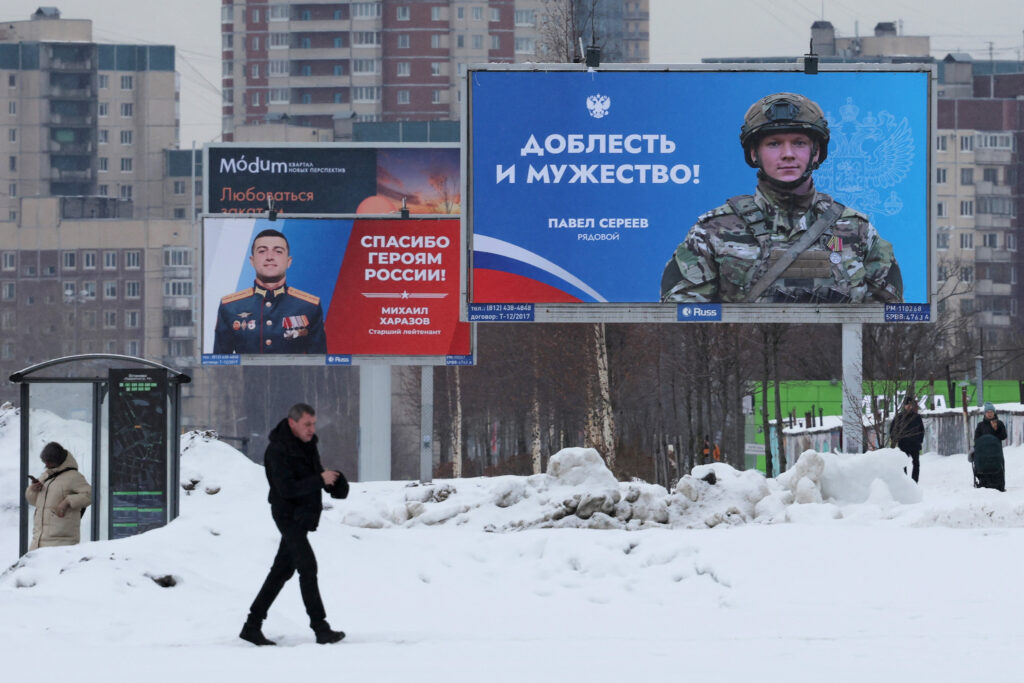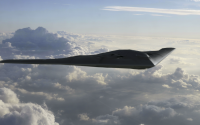The toll on Russia from its war in Ukraine, by the numbers
The numbers don’t lie. Two years after Russian President Vladimir Putin launched his full-scale invasion of Ukraine on February 24, 2022, the humanitarian and economic costs to Ukraine have been immense. But the war has also wreaked devastating self-inflicted wounds on Russia, including catastrophic casualty rates, growing economic isolation from the West, and the mass emigration of skilled workers. Below, our experts quantify the staggering human and economic toll that the invasion of Ukraine has cost Russia since the war began.
The autocratic regime of Vladimir Putin is doubling down on fear, a trend that has accelerated since Russia’s invasion of Ukraine two years ago. This dynamic was dramatically demonstrated by the suspicious death of opposition leader and anti-corruption activist Aleksei Navalny last week in a Russian prison. It is also borne out by the numbers. According to data from the human rights organization OVD-Info, which compiles statistics on political persecution in Russia, there are currently 892 criminal cases against anti-war dissidents, and a total of 19,855 people have been detained at anti-war protests. The OVD-Info data also show a sharp uptick in Russians being detained for political reasons since the invasion. Of the 3,626 people in Russia subject to politically motivated prosecutions since 2012, more than one third, a total of 1,305, have come in the past two years (728 in 2022, 521 in 2023, and 56 thus far in 2024). The Kremlin’s decision to double down on fear is in fact a function of its own fear. Political change in Russia tends to come when three factors are present: a divided elite, a disaffected public, and an absence of fear. The Putin regime appears determined to assure that for the foreseeable future, fear will not be in short supply.
—Brian Whitmore is a nonresident senior fellow at the Atlantic Council’s Eurasia Center, an assistant professor at the University of Texas-Arlington, and founder and host of “The Power Vertical” podcast.
Launching the full-scale invasion of Ukraine led Russia to lose a significant natural gas market share and revenues in Europe. In 2024, Russia’s projected loss stands between twenty-seven and thirty-four billion dollars (assuming a price of seven to nine dollars per one million British thermal units of Dutch TTF gas). For context, these figures track closely to Russia’s planned spending on education and health care in 2024, allocations that have dropped as funding was diverted toward Moscow’s brutal military campaign.
Ironically, Europe’s race to phase out coal while maintaining industrial competitiveness would have led to an increase in Russian gas exports to the continent had Putin chosen economic prosperity over bloody, unprovoked aggression. This increase would have occurred regardless of whether the Nord Stream 2 pipeline came online. Moscow would have been on course to ship more than 184 billion cubic meters (bcm) of gas to Europe in 2024, according to an assessment by Rystad Energy that will be featured in a forthcoming Atlantic Council Global Energy Center report. Instead, Russia sent around 72 bcm piped and liquefied natural gas in 2023—a number that’s expected to remain steady this year unless new limits or sanctions are put in place. These figures speak to the unprecedented pivot from Russian energy sources in Europe as well as the urgent need for Europe to fully decouple from Russian supply chains. Energy exports remain the main mechanism for Russia’s ability to finance two years of a full-fledged war in Ukraine, as almost a third of Russian revenues comes from the oil and gas sectors.
—Olga Khakova is the deputy director for European energy security at the Atlantic Council’s Global Energy Center.
As of December 2023, 315,000 Russian troops have been killed or wounded in Ukraine, according to declassified intelligence shared with Congress. With a ground force of 360,000 prior to the invasion, Russia has expended almost 90 percent of its prewar troops, an unimaginable loss for a country that has claimed to be the world’s second-strongest military. Russia’s highly attritional tactics, which often include pushing troops forward to the point of inoperability before being rotated out, have also included the use of human wave attacks, in which Russia engages in offensive efforts around places such as Bakhmut and Avdiivka by throwing masses of poorly trained and poorly armed Russian soldiers onto entrenched Ukrainian positions.
To put these numbers in context, Russia’s losses in the recent four-month campaign for Adviikva, according to figures provided by Ukraine’s military, were greater than the Soviet Union suffered in its decade-long war in Afghanistan.
Russia’s high casualty rates in this war have acutely set back its fifteen-year-long effort to modernize its ground forces as Russia has taken “extraordinary measures” to sustain its fighting capacities, including the recruitment of convicts and older civilians. As long as Ukraine stays in the fight, Russia is likely to have irrevocably lost its force quality for the duration of this war.
—Olivia Yanchik is a program assistant with the Atlantic Council’s Eurasia Center.
In 2022, 10 percent of the information technology (IT) workforce left Russia, along with more than one thousand Western firms. The IT sector is vital to the Russian economy, having driven nearly a third of the country’s growth since 2015. In the months following the invasion, Moscow offered lower income taxes and mortgage rates to IT workers to retain talent. Yet these measures failed to stop more than one hundred thousand of these young, highly-educated professionals from leaving the country. According to the Russian minister for digital development, the IT sector now faces a shortfall of over half a million workers.
The effects of a growing “brain drain” are compounded by the exit of Western tech firms such as IBM, Intel, Microsoft, and others. Prior to the invasion, the sector was heavily reliant on Western inputs from semiconductors to operating systems. With access to Western technology severely hindered by sanctions, few domestic alternatives exist, and Chinese technology has proven an imperfect and costly substitute. The sector is now deprived of access to global connectivity, research, scientific exchanges, and critical technology components, and in the long term is likely to fall behind other global powers such as the United States, China, and the European Union (EU).
—The Economic Statecraft Initiative within the GeoEconomics Center publishes leading-edge research and analysis on sanctions and the use of economic power to achieve foreign policy objectives and protect national security interests. This post is adapted from the Economic Statecraft Initiative’s Russia Sanctions Database.
As of today, 444 individuals are currently designated foreign agents and undesirable organizations. Russia has used its foreign agents law to designate these groups and entities “foreign agents” under legislation that allows it to punish individuals and target groups for allegedly receiving support from outside of Russia or operating under foreign “influence.” The undesirable organizations law also allows Russia to completely ban entities deemed “undesirable” for supposedly compromising Russia’s defense or security capabilities or “constitutional order.” A total of 535 groups and individuals have been designated under these laws and placed on foreign agent and undesirable organization registries since 2022, comprising a majority of the total 920 designated since 2013, some of which are no longer currently listed.
Since launching its full-scale invasion of Ukraine, the Russian government has expanded and applied these laws extensively to crack down on independent media, civil society organizations, and other entities and individuals perceived as threatening to the Kremlin’s grip on power and war effort. Liberal use of the purposefully vague language of these laws has given the Russian government nearly unfettered power to silence opposition, eliminating the space for free expression and limiting social, political, and humanitarian work in and with Russia. Consequently, these laws have taken a massive toll on civil society and deprived Russians of access to information—particularly damning as the Kremlin works to mask the realities of its brutal war in Ukraine under a veil of pro-Kremlin and pro-war propaganda narratives.
—Mercedes Sapuppo is a program assistant at the Atlantic Council’s Eurasia Center.
In the weekend following February 24, 2022, the Group of Seven (G7) nations decided to ban transactions servicing the Russian Central Bank (CBR). The measure—implemented by the entire EU and a handful of other like-minded partners—keeps this money out of Moscow’s reach. The assets have not been frozen. Indeed, uncertainty remains on where a minority of the funds are. Still, we now know much more than even the US government did on the first anniversary of the invasion, and it is now clear that the block is working.
To arrest the ruble’s depreciation, CBR Director Elvira Nabiullina was forced to implement capital controls, which she had always ruled out prior to Russia’s full-scale invasion. Had the G7’s ban not been in place, she could instead have used the reserves to intervene in currency markets. Breaking the taboo on capital controls will cost in the long term as foreign investors will always remember that they may struggle to transfer returns out of Russia.
Moscow has practically written the money off. Two G7 statements say the block will only be lifted if Russia retreats behind Ukraine’s 1991 borders and pays compensation for the damage it has wrought, so the money will not come under Russia’s control any time soon. While simply using the assets for Ukraine’s reconstruction remains unlikely for now, the European Council has recently agreed to transfer the interest income and the principal may also be used to help Ukraine borrow more cheaply.
—Charles Lichfield is the deputy director and C. Boyden Gray senior fellow, of the Atlantic Council’s GeoEconomics Center.
The Ukrainian Office of the General Prosecutor has 685 suspects in its main case of aggression, including ministers, deputies, military commanders, officials, heads of law enforcement agencies, and “instigators of war and propagandists of the Kremlin.” It has 125,698 registered crimes of aggression and war crimes, and as of November 14, had completed war crimes trials against 238 military personnel.
For the situation in Ukraine, the International Criminal Court (ICC)’s Office of the Prosecutor (OTP) has only two public suspects, both accused of war crimes. There are plenty of reasons for the disparity. The ICC is a court of last resort, operating on the principle of complementarity. It also is required to focus on the parties that “bear the greatest responsibility,” which is generally not a requirement and is often difficult to pursue within domestic courts given immunities.
The OTP is likely to release more arrest warrants in coming years while balancing other investigations. Meanwhile, the Ukrainian general prosecutor can continue to develop capacity, working with the OTP and allied countries to best divide responsibilities and hold fair and efficient proceedings. Jointly, the resulting arrest warrants will help ensure that Russian perpetrators either will be unable to travel freely or will face trial.
—Celeste Kmiotek is a staff lawyer for the Strategic Litigation Project at the Atlantic Council.
G7 coalition members imposed the oil price cap in December 2022 with the goal of minimizing Russia’s oil revenues. For the first few months of 2023, the price of Russian oil remained below the cap of sixty dollars per barrel, which was taken as a sign of this novel measure’s success. However, the policy came under scrutiny in September 2023 when the oil price exceeded eighty dollars per barrel.
The oil price cap has reduced revenues for Moscow, but enforcement challenges have undermined its effectiveness. To circumvent the price cap, Russia reduced reliance on G7 shipping services, and switched to the use of “shadow fleet” tankers. Shadow fleet tankers allow Moscow to charge higher fees for oil and manipulate vessels’ locations. The lack of information on beneficial (actual) owners of tankers and complex ownership structures of maritime companies have made it difficult to counter Russia’s circumvention efforts.
The US Treasury Department is addressing these enforcement challenges by building compliance capacity in the maritime industry and also sanctioning the price cap violation networks. On February 1, the Price Cap Coalition published the Oil Price Cap (OPC) Compliance and Enforcement Alert, which provides an overview of key OPC evasion methods and guidance on how to report suspected breaches across the Price Cap Coalition. One week later, the Treasury’s Office of Foreign Assets Control designated a network of four entities based in the United Arab Emirates and Liberia and one tanker registered in Liberia because of their involvement in the price cap violation scheme. The combination of capacity-building measures and targeted designations of the evasion network is likely to enhance the effectiveness of the price cap and further reduce Moscow’s oil revenues.
—The Economic Statecraft Initiative within the GeoEconomics Center publishes leading-edge research and analysis on sanctions and the use of economic power to achieve foreign policy objectives and protect national security interests. This post is adapted from the Economic Statecraft Initiative’s Russia Sanctions Database.
The Soviet Union, which Putin so often laments the collapse of, was a powerhouse in the Olympics. During its existence, more than 1,700 Soviet athletes won an Olympic medal in sports ranging from weightlifting to table tennis. Individual triumphs, such as Belarusian Olga Korbut in gymnastics in 1972, generated awe and admiration around the world—even in the anticommunist West. For the Soviets, the Olympics were a way to attract positive attention and accrue soft power.
In a little more than 150 days, 4,600 athletes will descend upon Paris for the 2024 Summer Olympics. According to the most recent count, just six Russian and five Belarusian passport holders will compete. By the opening ceremony, these numbers may rise somewhat if more athletes qualify, but none will compete under the Russian flag, and none will hear the Russian national anthem on the medal stand.
After Russia’s full-scale invasion of Ukraine, the International Olympic Committee (IOC) condemned the “senseless war.” Russians were banned from competing in the Olympics under their own flag, as were Belarusians for their country’s role as a staging ground for Russia’s invasion. In December 2023, the IOC announced that some qualifying Russian and Belarusian passport holders could still compete in Paris, but they must do so under the banner of Individual Neutral Athletes.
In his marathon end-of-year address, Putin whinged to his captive audience that the “very idea of Olympism has been tarnished.” He’ll just have to settle for watching the more than sixty Ukrainian athletes competing in Paris.
—John Cookson is the editor of the Atlantic Council’s New Atlanticist section.
Image: A man walks past banners in support of the Russian Army in Saint Petersburg, Russia February 5, 2024. REUTERS/Anton Vaganov



